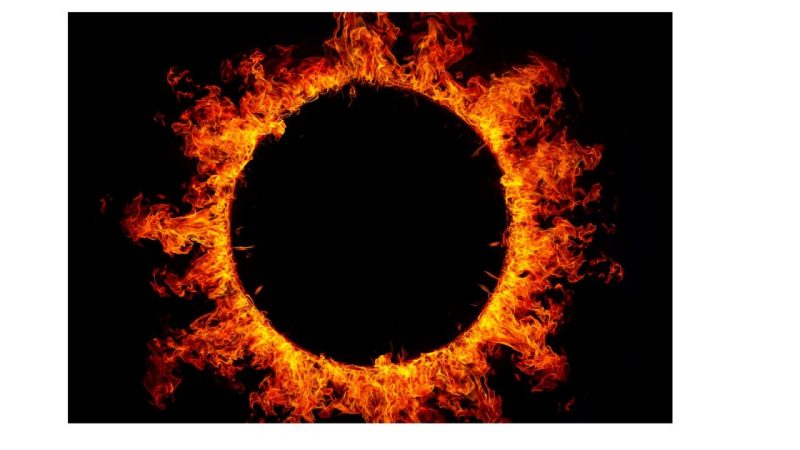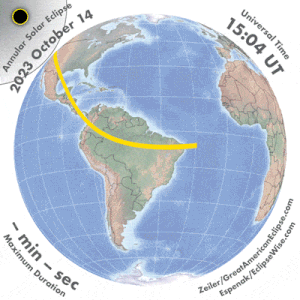You can see a ‘ring of fire solar eclipse’ today, here’s how

The annular solar eclipse, also known as the ‘ring of fire’, is about to unfold on Saturday, October 14. This phenomenon occurs when the Moon passes between the Earth and the Sun. Do not miss out on this rare opportunity if you’re in the ‘right zone’ as the next annular solar eclipse won’t pass over the U.S. until 2046. Here’s everything you need to know about this rare event.
The annular solar eclipse, will be visible from North, Central, and South America.
The eclipse begins in Oregon at 9:13 a.m. PDT (12:13 p.m. EDT) and gradually moves through seven other U.S. states. It then proceeds over the Gulf of Mexico and travels across Mexico, Guatemala, Belize, Honduras, Nicaragua, Costa Rica, Panama, Colombia, and Brazil, giving millions of people a chance to witness the “ring of fire.”
An annular eclipse occurs when the Moon is at or near its farthest point from Earth. This causes the Moon to appear smaller, and when it passes in front of the Sun, it doesn’t fully block it. Instead, it leaves a brilliant ring of sunlight around the Moon’s edges, creating the captivating “ring of fire” effect.
Watch Live Here
The path of annularity, where the full “ring of fire” will be visible, is a narrow 125-mile-wide track. This path stretches from Oregon through Texas, offering incredible opportunities for eclipse-watchers. The total duration of the “ring of fire” varies by location, with some areas experiencing it for over four minutes.
If you’re not in the path of annularity, you can still witness a partial solar eclipse, where the Moon appears to take a ‘bite’ out of the Sun. This partial eclipse will be visible throughout the contiguous U.S., as well as in Puerto Rico and parts of Alaska and Hawaii.
To ensure your safety while observing the eclipse, always use specialized solar filters or indirect viewing methods. It’s never safe to look directly at the Sun without proper eye protection. Solar viewing glasses and pinhole projectors made from household materials are two easy and safe ways to experience the eclipse.
The annular solar eclipse is also an opportunity for citizen science. GLOBE Observer and Eclipse Soundscapes allow citizen scientists to submit observations on sounds, temperature, cloud cover, and more to assist in understanding how eclipses impact Earth’s atmosphere and animal life.

In addition, NASA offers STEM learning resources tied to the eclipse.
For those fortunate enough to be near the path of annularity, locations such as Oregon Dunes, Crater Lake National Park, and Great Basin National Park in the U.S. will experience the “ring of fire” for several minutes. Make sure to check the local weather conditions and be prepared to change your location if needed, as clear skies are essential for eclipse viewing.
According to NASA, the 2023 annular solar eclipse serves as a prelude to the highly anticipated 2024 total solar eclipse that will cross the U.S. from Texas to Maine. While this year’s eclipse provides a great excuse for travel and is a unique spectacle in its own right, the 2024 eclipse promises to be even more extraordinary.
During the 2023 eclipse, viewers located at the northern edge of the path of annularity, like Dolores, Colorado, and Santa Fe, New Mexico, may experience a shorter but dramatic spectacle. The ring of fire will be visible for just a few seconds, but the moon’s edge may create a stunning effect, reminiscent of “Baily’s beads” seen during a total solar eclipse.
However, for most Americans, the 2023 eclipse will offer a substantial partial solar eclipse, with varying degrees of obscuration depending on location. The 10 largest cities in the U.S. will experience different levels of eclipse coverage, with only San Antonio witnessing the “ring of fire.”
Here’s what to expect in some major cities on Oct. 14:
- New York: 23% coverage at 1:22 p.m. EDT
- Los Angeles: 71% coverage at 9:24 a.m. PDT
- Chicago: 43% coverage at 11:58 a.m. CDT
- Houston: 85% coverage at 11:58 a.m. CDT
- Phoenix: 79% coverage at 9:31 a.m. MST
- Philadelphia: 25% coverage at 1:21 p.m. EDT
- San Antonio: Witnessing the “ring of fire” at 11:52 a.m. CDT
- San Diego: 68% coverage at 9:26 a.m. PDT
- Dallas: 80% coverage at 11:52 a.m. CDT
- San Jose, California: 75% coverage at 9:20 a.m. PDT
As said earlier, always use solar filters to safely view the eclipse to protect your eyes . Whether you’re witnessing a partial or annular solar eclipse, the potential dangers remain the same. Solar eclipse glasses are essential, and any optical equipment such as cameras, telescopes, or binoculars should have solar filters in place to safeguard your vision.

Today’s annular solar eclipse is a remarkable celestial event that will offer a unique experience for sky-watchers across the Americas. Make sure to plan your viewing strategy properly to ensure your safety to witness this extraordinary display in the sky.



An annular solar eclipse is crossing the United States today and New Mexico is in the direct path of the eclipse. According to NASA, the solar eclipse will be visible in many parts of New Mexico, starting in the northwest of the state and ending in southeastern New Mexico. The best views are in the cities of Farmington, Albuquerque, Roswell and Hobbs, where about 90% of the eclipse will be visible. Areas outside the eclipse path can see about 80% of the eclipse.